JERUSALEM: PART II
How lovely is your dwelling place, O Lord of hosts!
My soul longs, yes, faints for the courts of the Lord;
My heart and flesh sing for joy to the living God…
Blessed are the men whose strength is in You,
in whose heart are the highways to Zion…
For a day in Your courts is better than a thousand elsewhere…
O Lord of hosts, blessed is the man who trusts in You (Ps. 84:1,2,5,10,12- Song of a pilgrim).
Mount Zion is a hill in Jerusalem, located just outside the walls of the Old City. The term “Mount Zion” has been used in the Hebrew Bible for three different locations: The City of David, the Temple Mount, and the Western Hill.
Lower Eastern Hill (City of David): First, Mount Zion was the name given to the lower part of the eastern hill, the stronghold once occupied by the Jebusites. When it was conquered by David, the area was partially rebuilt by him and renamed the “City of David”, where he built his palace.
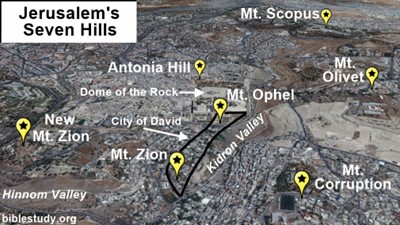
King Solomon, son of David, built the first temple of Jerusalem on Mount Moriah, north of the City of David. Solomon’s temple provided a place for the ark of the covenant. The temple became the central place for offering sacrifice to God. It stood for many centuries until the Babylonians destroyed it. The ark of the covenant was hidden in an underground chamber, but it is not known what has happened to it.
Upper Eastern Hill (Temple Mount): Once the Temple of Solomon was built at the top of the Eastern Hill, the name “Mount Zion” shifted there, and the top of the hill was generally known as the Temple Mount. Today, there are only the remains of the temple platform. What dominates this area is the Dome of the Rock, a golden-domed shrine sacred to Islam. It was built in 691 over the “foundation rock” which, according to the Jewish tradition, is the place where Abraham intended to sacrifice his son Isaac. According to Muslim tradition, the rock is the place where Muhammad ascended to paradise and then back to Mecca after his night journey. On the southern side of the Temple Mount, the silver-domed Al-Aqsa Mosque, also commemorates the night trip of Muhammed. It was built in 1035.
In the time of Jesus, the temple constructed by Herod the Great stood on the Temple Mount. Herod had actually doubled the area of the Temple Mount to 144,000 square meters. His work on the Temple is dated from 20/19 BC to 12/11 BC. Religious worship and temple rituals continued during the reconstruction, and Herod had an agreement with the Jewish religious authorities that the Temple would be built by the priests. Since functioning did not stop, Herod’s Temple is still counted as the Second Temple, although it was the third building to fulfil its religious purpose. In addition to the temple, it included porches, gates, courts, a ritual bathhouse, and the Antonia Fortress. Jesus spent much time teaching around these structures, but never entered the temple itself since He was not a Jewish priest.

Western Hill (today’s Mount Zion): The last move of the name “Mount Zion” was to the highest part of Jerusalem’s Western Hill. It was probably transferred here either at the end of the first or at the beginning of the second century AD during the Christian period following the Roman destruction of Jerusalem. Several events important to the early church took place here: The Last Supper, the appearance of Jesus before the high priest Caiaphas, Pentecost and the Dormition of the Blessed Virgin Mary.
In a wider sense, “Mount Zion” was and is used also for the entire Land of Israel.
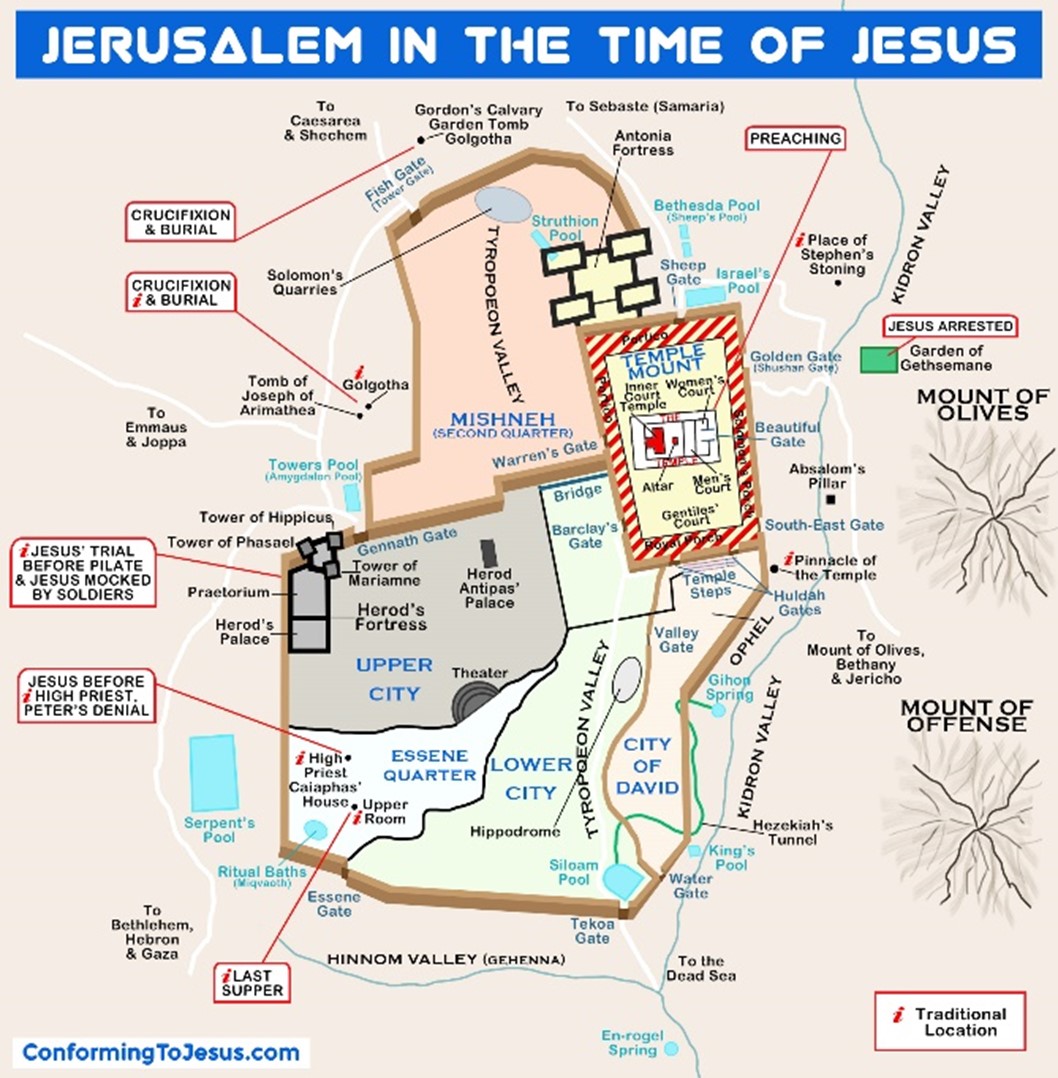
Church of St. Peter in Gallicantu
On the highest part of Jerusalem’s Western Hill (Mount Zion) was the House of Caiaphas. Jesus was taken to the high priest’s residence after His arrest in the garden of Gethsemane late Holy Thursday evening, and was questioned by Caiaphas and beaten and ridiculed by the guards. Having followed Jesus and those who arrested Him, Peter sat around a fire in the courtyard while Jesus’ trial before the Sanhedrin (Mk. 14:53-72) was taking place inside. It was here that Peter betrayed His Master by denying Him three times. The lowest level of the building is very likely the pit in which Jesus spent the night (Mk. 15:1) before His death.
The Church of St. Peter in Gallicantu stands on the House of Caiaphas and commemorates both the House of Caiaphas and the denials of Peter. Gallicantu comes from two Latin words, gallus and cantare, and means “the cockcrow.” In the picture of the church, we can see that a golden rooster is mounted on the church’s roof, recalling Jesus’ words at the Last Supper that Peter would deny Him three times before the cock crowed (Jn. 13:38).
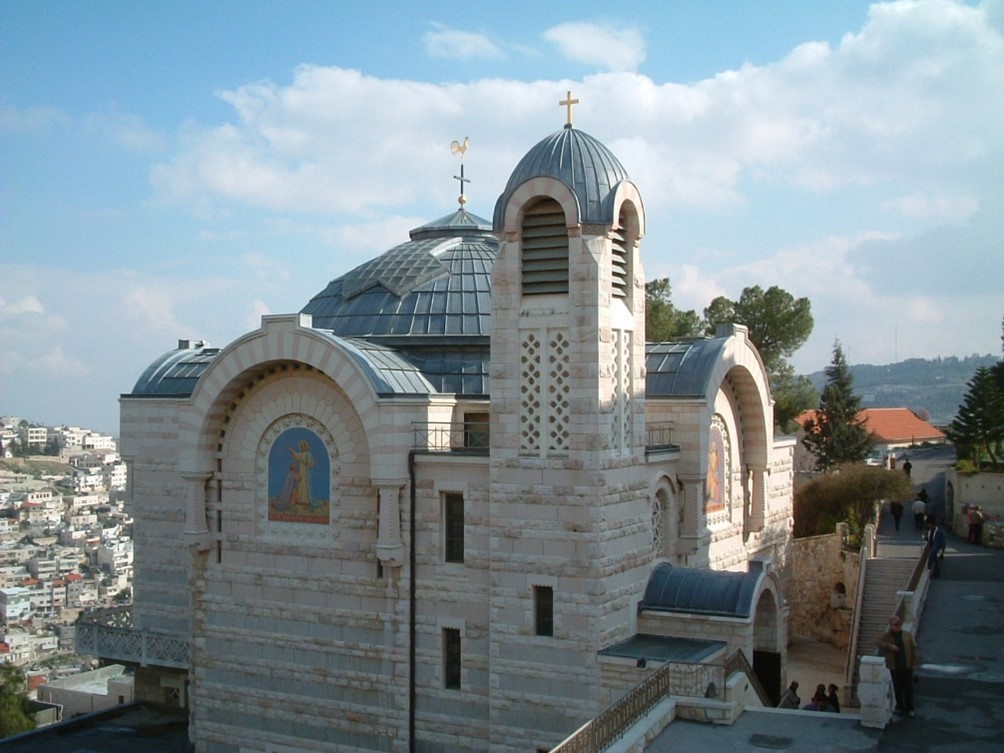
Reflection: How have I denied Him? How have I witnessed to Him?
The Cenacle on Mount Zion is thought by many to be the famous “Upper Room” where many events described in the New Testament took place. Here in the Upper Room:
The Passover meal was prepared and Jesus celebrated the new Passover with His disciples (Mk. 14:12-16; Lk. 22:7-13).
Jesus washed the feet of His Apostles during supper (Jn. 13:4-11)
He instituted the Eucharist (Mt. 26:26-29; Mk. 14:22-25; Lk.22:17-20; I Cor. 11: 23-27).
Jesus appeared to the Apostles after the Resurrection (Mk. 16:14; Lk.24:33; Jn. 20:19).
The Apostles and Mary gathered “devoting themselves to prayer” after the Ascension of Jesus (Acts 1:13-14).
The Holy Spirit descended upon the Apostles and Mary at Pentecost (Acts 2:1-4).
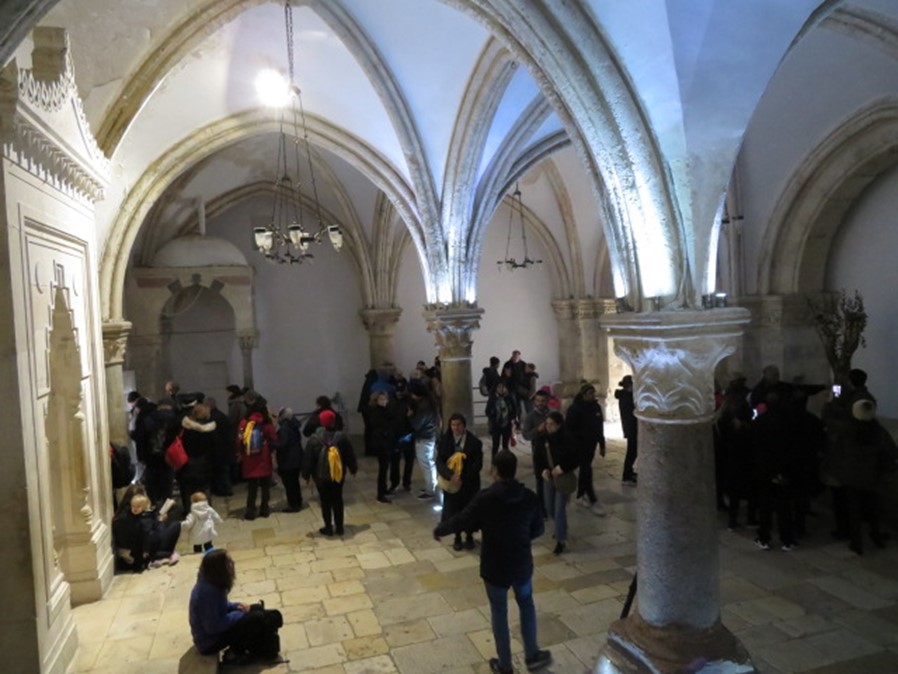
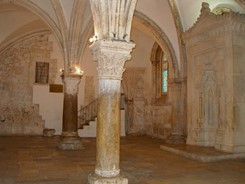
The word “Cenacle” is derived from the Latin word “cenare” “to dine”. “Cenaculum” is “the supper room.” After the Passion and Resurrection of Jesus, this room became the center of early Christianity in Jerusalem (Binz, Holy Land Pilgrimage, p. 226).
Reflection: *Attending Mass every day, we can take what is going on for granted. Do we appreciate what is actually happening in the Holy Sacrifice of the Mass: a re-presentation of Calvary, the act of obedience that won for us our salvation. Are we truly grateful for this mystery and express it through an act of thanksgiving after Mass?
*Let us reflect on Isaiah 2:2-3. Many early Christian writers saw in the aftermath of Pentecost, a fulfilment of this prophecy.
2: “In days to come, the mountain of the Lord’s house shall be established as the highest mountain and raised above the hills. All nations shall stream toward it.
3: Many peoples shall come and say: ‘Come, let us go up to the Lord’s mountain, to the house of the God of Jacob, that he may instruct us in his ways, and we may walk in his paths.’ For from Zion shall go forth instruction, and the word of the Lord from Jerusalem.”
In the Apostles’ preaching after Pentecost (Acts 2:5-13), we see the fulfilment of this passage. Pentecost was the “day to come.” The “mountain…raised above the hills” was Mount Zion. “From Zion shall go forth instruction” refers to the disciples who, after leaving the Upper Room began to carry out the Lord’s final instructions to them: “Go, make disciples of all nations baptizing them…teaching them to observe all that I have commanded you” (Mt. 28:19-20) (Charles Samson, Come and See: A Catholic Guide to the Holy Land, p. 184-5).
*Concerning the coming of the Holy Spirit (Acts 2:1-4), do I pray that He comes? Do I pray “Come, Holy Spirit,” when my prayer is dry or when I need an outpouring of one of the gifts of the Holy Spirit? Or when I need the presence of the Paraclete, our Advocate or the Consolator, our Comforter?
In 333, there was a synagogue here. The building has been destroyed and rebuilt many times. What remains today is the Gothic Crusader structure. In this church there are four chapels, two above and two below. Steps led from the lower to the Upper Room. The Cenacle was either repaired or enclosed by the Crusader church. Even though much of the Crusader church was destroyed in the late 12th or early 13th century, the Cenacle survived. Syrian Christians maintained the Cenacle until the 1330s when it passed into the custody of the Franciscans who managed the structure until 1524. They were expelled entirely from their surrounding buildings in 1550. At this time, the Ottoman authorities took possession of the Cenacle and converted it into a mosque. There are architectural remains of the period of Muslim control; for example, Arabic inscriptions on the walls, the minaret and dome on top of the roof. Christians were forbidden to enter it until the establishment of the State of Israel in 1948. The State of Israel Ministry of the Interior now manages this priceless structure.
Since the liturgy is not permitted inside the Upper Room, the Franciscans returned to an area close to the Cenacle in 1936 and built the Chapel of St. Francis ad (“near”) Coenaculum. This made it possible for services to be held “near” the Upper Room. A life-size bronze of the Last Supper stands in front of the church. Jesus is holding a large round bread that is the chapel’s tabernacle.
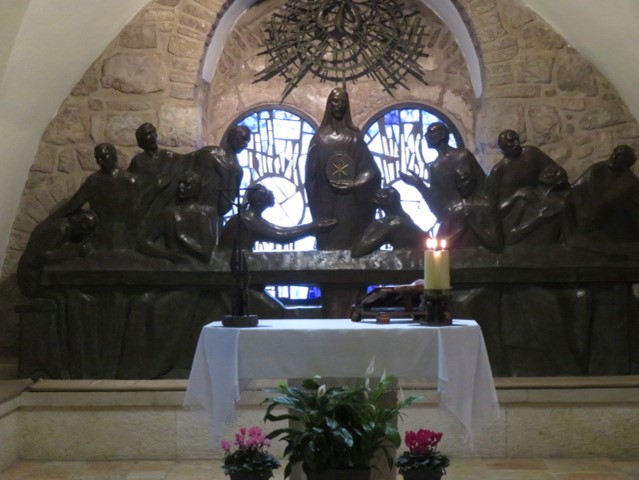
The general location of the Cenacle is also associated with that of the house where the Virgin Mary lived among the Apostles until her dormition, which is celebrated in the nearby Church of the Dormition.

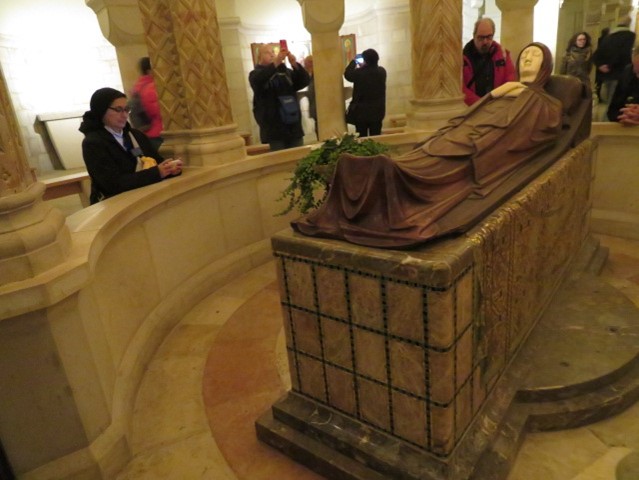
The Abbey of the Dormition is a Benedictine Abbey on Mount Zion near the Zion Gate. According to local tradition, it was the place, near the site of the Last Supper, that the Blessed Virgin experienced “falling asleep.” Hence, the name of the Abbey. Earliest traditions tell us that at the end of her life, Mary lived in Jerusalem. The apostles, who were preaching throughout the world, returned to Jerusalem and gathered at her bedside. The present complex was completed in 1910. It is built on two levels: The main altar and monastic choir on the upper level and the crypt with its Marian shrine on the lower. Six side chapels in the upper church contain beautiful mosaics. The center of the crypt on the lower level contains a simple bier on which rests a life-size statue of Mary, fallen asleep in death. The figure is made of cherry wood and ivory. Her eyes are closed and her hands crossed.
Reflection: Let us reflect here on the assumption of Mary into heaven. Mary experienced the resurrection and glorification of her body at the moment her earthly life ended. Her assumption, which flows from her unique participation in Christ’s victory as the mother of the Savior and as the first and most faithful follower of Christ, anticipates to some degree our own share in the fullness of that victory, if we persevere as followers of Christ in our religious life. St. Pope John Paul said that the Assumption was an “event of love”. Does this not offer us hope that, with whatever we are facing in life, we may, like Mary, fall into the Father’s arms, and experience His raising us up to Himself, now and at the hour of our death? (Based on a reflection by Edward Sri)
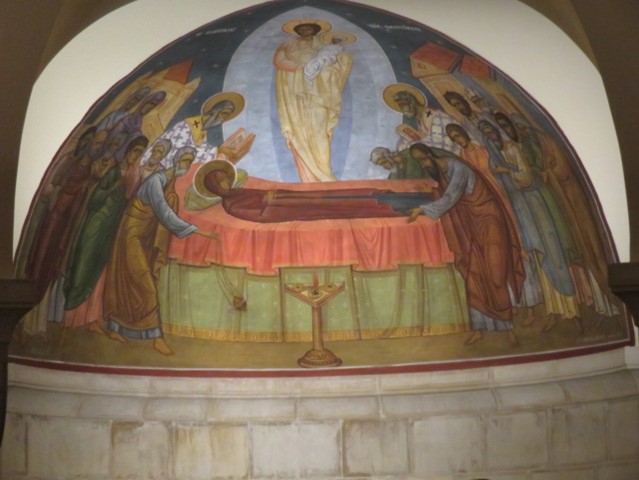
There are many chapels, donated by different countries, around the walls of the crypt. One of them is a fresco showing Mary, like the statue, lying in death. The apostles are gathered around her, and Christ is shown in glory. He is holding the soul of Mary in His arms. She is wrapped in a burial cloth and presented as if she were a newborn child (Bing, p. 231).
Reflection: Can I imagine the sorrow of the apostles as they gather around Mary?
Praetorium of Pilate
(See map below) Near the House of Caiaphas (Church of St. Peter) was the Praetorium of Pilate (Santa Sophia Church). In the Book of Theodosius from 530 AD, we read: “From the House of Caiaphas up to the Praetorium of Pilate, there are nearly 100 (double) steps. Here is the Church of Holy Wisdom.” Based on this description and on other Byzantine witnesses, it is “likely” that the Praetorium of Pilate, where Jesus was condemned to die and where he took up the Cross for the salvation of the world, was to be found in the complex of the lower Hasmonean palace near the southwestern corner of the Jewish Temple complex (Samson, p. 200).
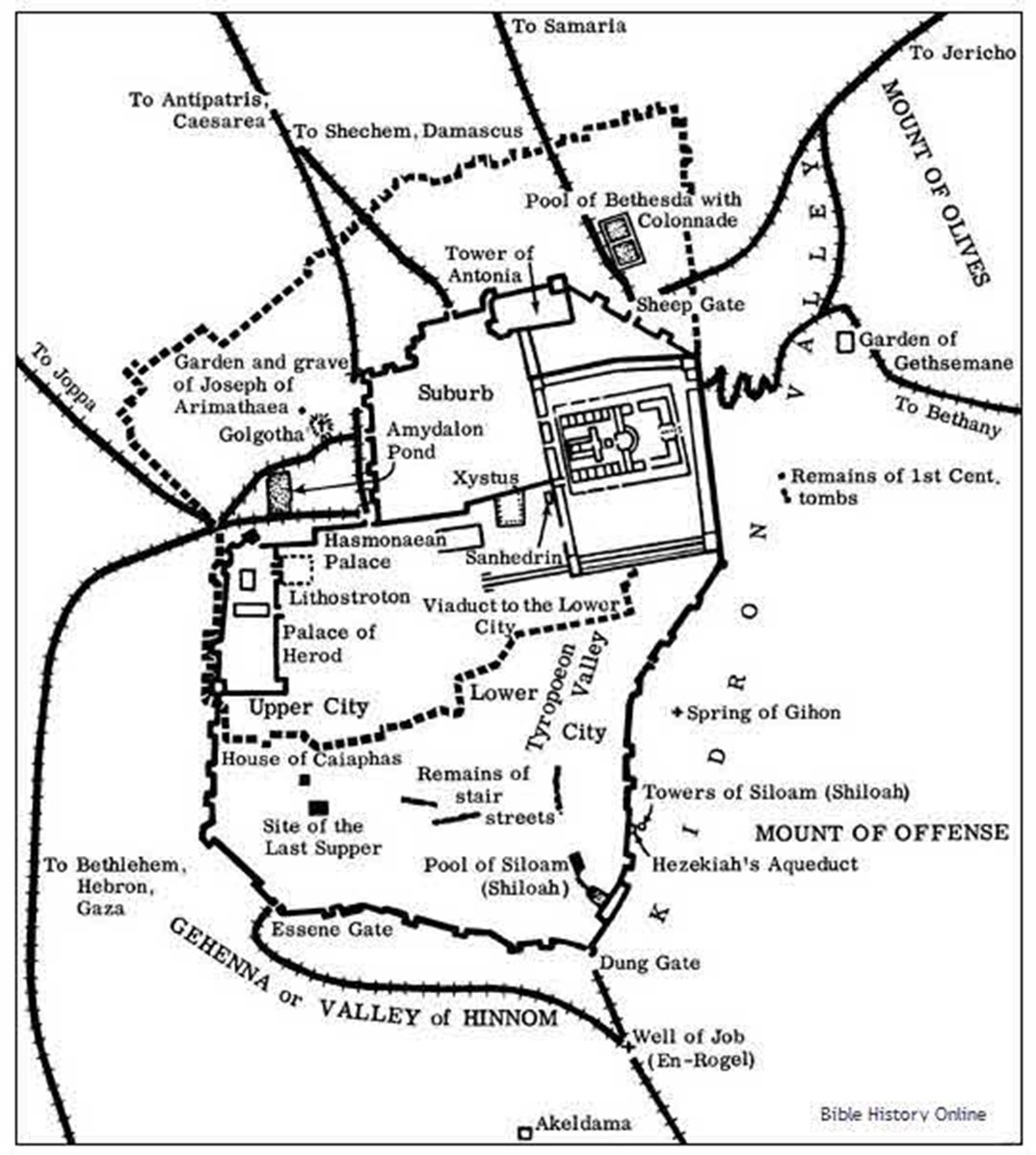
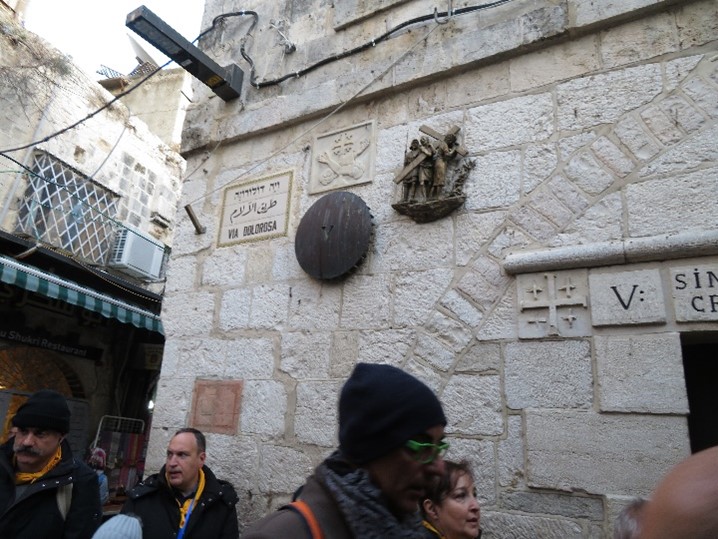
Via Dolorosa or Via Crucis
The Via Dolorosa or “Sorrowful Way” is the path that Jesus took on the way to His crucifixion. Today, it is very unlikely that the current Via Crucis (“Way of the Cross”) follows the actual path of Jesus to Calvary. We assert this point based on archaeology and history. In fact, the tradition of making a pilgrimage to the Holy Land to walk the Via Dolorosa in order to follow in the footsteps of Jesus on His way to crucifixion, began in the mid-4th century when Constantine legalized the Christian religion, and it became safe to travel. These Byzantine pilgrims followed practically the same path as the one taken today, except that there were no individual stations, no stopping on the way. They started at the top of the Mount of Olives, stopped at Gethsemane, entered the Old City at the Lions’ Gate on the east side, and followed today’s route to the Church of the Holy Sepulcher.
The route has changed several times. By the 8th century, the route went from the western hill instead of the top of the Mount of Olives, then to Gethsemane, continued to the House of Caiaphas on Mount Zion, then to the site of the Praetorium (Santa Sophia Church), and then to the Church of the Holy Sepulcher.
During the Middle Ages, there were two rival routes, based on the split in the Latin Church, one controlling the churches on the western hill, the other controlling churches on the eastern hill. They supported the route that took the pilgrims passed the churches that each controlled: one argued that Pilate’s Praetorium was on Mount Zion (where they had churches), the other that it was near the Antonia Fortress (where they had churches).
In the 14th to the 16th centuries, pilgrims followed the Franciscan route. Pope Clement VI in the 14th century established the Franciscan Custody of the Holy Land, charging the friars with “the guidance, instruction, and care of the Latin pilgrims as well as with the guardianship, maintenance, defense and rituals of the Catholic shrines of the Holy Land.” In 1350, the Franciscan route began with the Church of the Holy Sepulcher and included eight stations. Around this time, the tradition of 14 Stations of the Cross was developing in Europe; so six more stations were added to avoid disappointing European pilgrims.
Today the main route of the Via Dolorosa is that of the early Byzantine pilgrims, with 14 stations. St. Francis, who had a great love for Christ Crucified and regularly contemplated the Passion and Death of Christ, founded the Province of the Holy Land in 1217, only eight years after the Pope orally approved his “forma vitae.” One of his followers, St. Leonard of Port Maurice, promoted the devotion of the Stations of the Cross extensively by preaching the Via Crucis at missions for 43 years and by setting up the Stations in 571 locations throughout Italy, including the Colosseum in Rome.
Reflection: With every Way of the Cross that we contemplate, may we unite ourselves with the sufferings of Mother and Son. In this way, we will contribute, not only to our own salvation, but also to the salvation of mankind.
Now let us make our way along the Via Dolorosa. The exact location of each event is not so important as the love and devotion with which we do it. And, the closer we get to Calvary, the more closely our path will merge with what was most likely the actual path of Christ.
Today, the devotional Way of the Cross begins just outside the Church of the Flagellation. It is located in the Muslim Quarter near Lions’ Gate (on the east side). It is part of the Franciscan Monastery of the Flagellation, which also includes the Church of the Condemnation and Imposition of the Cross. This is where the old Antonia Fortress (Temple Fortress built by Herod the Great) once stood.
Reflections on the Stations of the Cross by Mother M. Ingeborg, FSGM, 2010
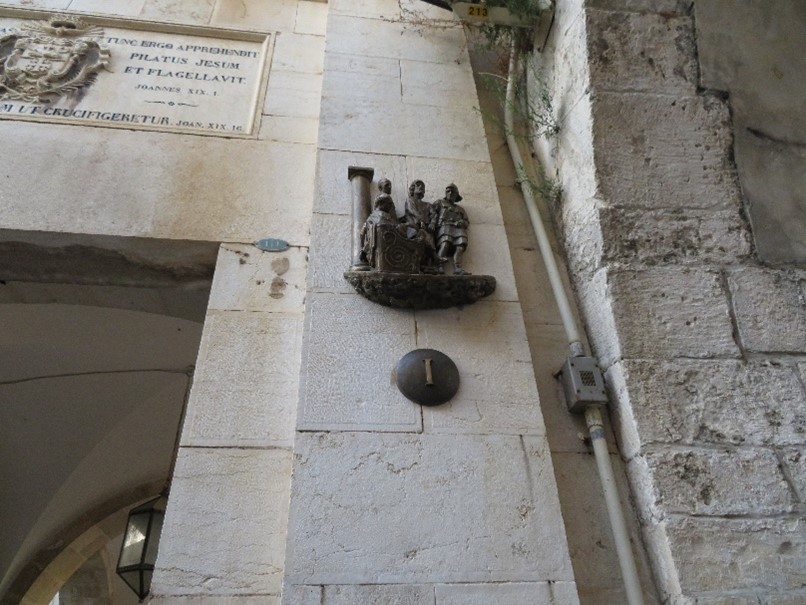
First Station: Jesus is condemned to death by Pontius Pilate
Reflection: You are condemned to death. I embrace my death whenever, wherever, however.
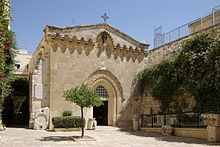
According to tradition, the Church of the Flagellation marks the spot where the Roman soldiers flogged Jesus before His journey down the Via Dolorosa to Calvary.
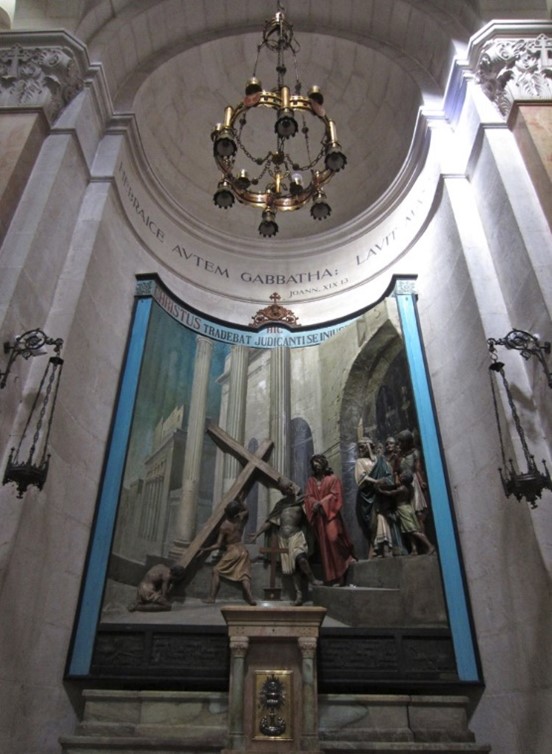
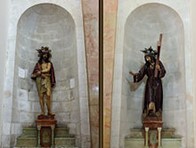
The Church of the Condemnation and Imposition of the Cross (Second Station) is located near the Church of the Flagellation and marks the spot traditionally said to be the place where Jesus was condemned to die and where He took up His cross.
Reflection: You embrace Your Cross. Grant me the grace never to complain about mine.
Stations three, seven, and nine claim, according to popular tradition, that Jesus stumbled three times, although there is no such mention in the Gospels.

Third Station
The Armenian Catholic Chapel commemorates the first fall.
Reflection: You fall underneath Your Cross. When I lay on the ground next to You, tell me to get up and keep going.
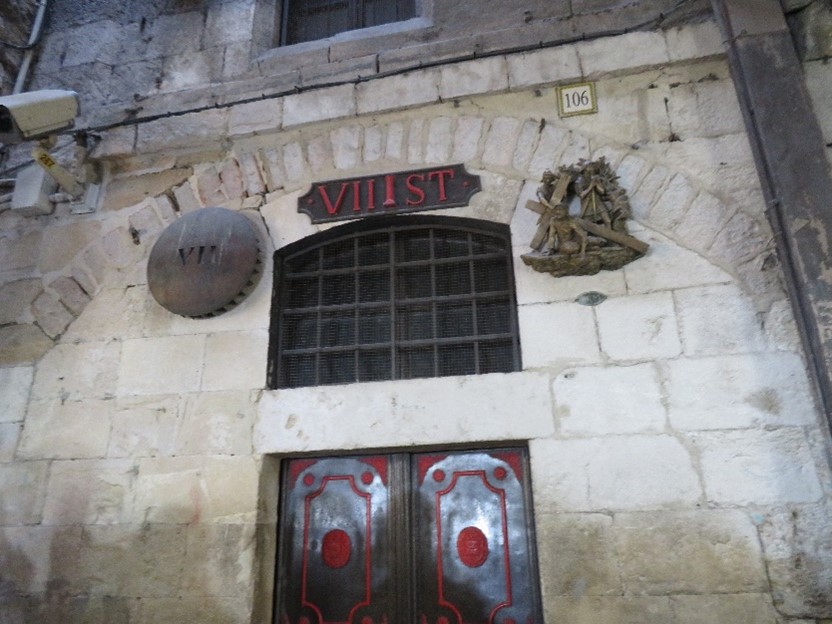
Seventh Station
The Seventh Station, Jesus falls the second time, is marked by a Franciscan chapel.
Reflection: If I could carry it triumphantly, it would not be my Cross. I fall again. Grant me the grace to get up again.
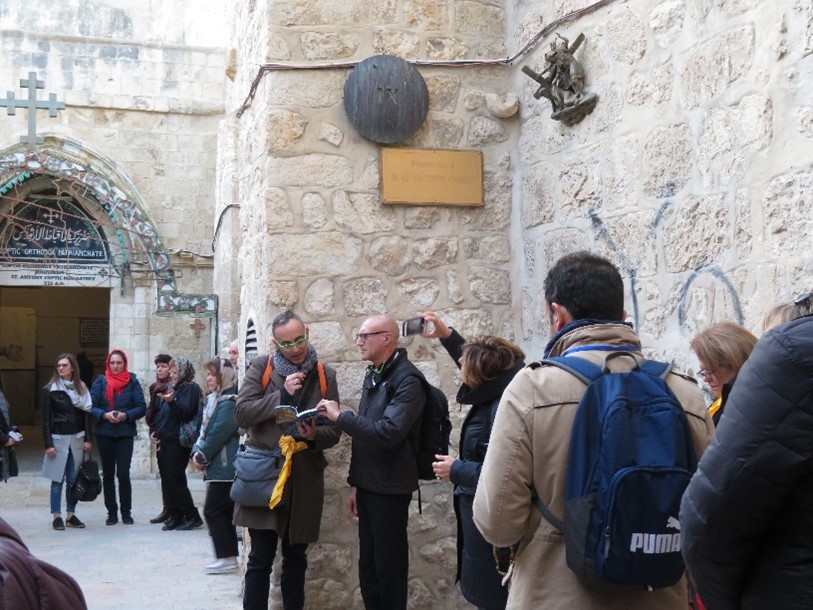
Ninth Station
The Ninth Station is located at the entrance to the Coptic Orthodox Patriarchate next to the Church of the Holy Sepulcher and commemorates the third fall.
Reflection: Let me always find You in my weakness.
Four Stations commemorate the encounters between Jesus and other people; one is mentioned in all the Synoptic Gospels and one is mentioned only in the Gospel of Luke; the other two exist in popular tradition.

The Fourth Station commemorates the popular tradition of a meeting between Jesus and His Mother on the Via Crucis and is located at the Armenian Catholic Patriarchate.
Reflection: Mother, please stay with me, too.
The Fifth Station, “Simon of Cyrene helps Jesus to carry His cross,” is found in the three Synoptic Gospels. John does not mention Simon of Cyrene, but emphasizes Jesus “bearing His own cross.” Thus “He went out to the place called the place of the skull, which is called in Hebrew Golgotha” (19:17).
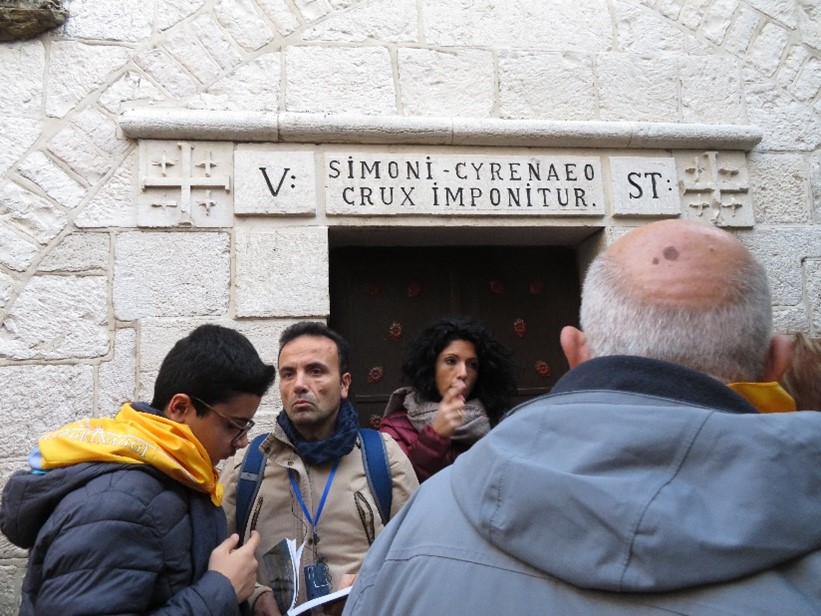
The Fifth Station is located at the Chapel of Simon of Cyrene, a Franciscan construction built in 1895.
Reflection: Yes, I will help You – in the people I meet – to carry the Cross.
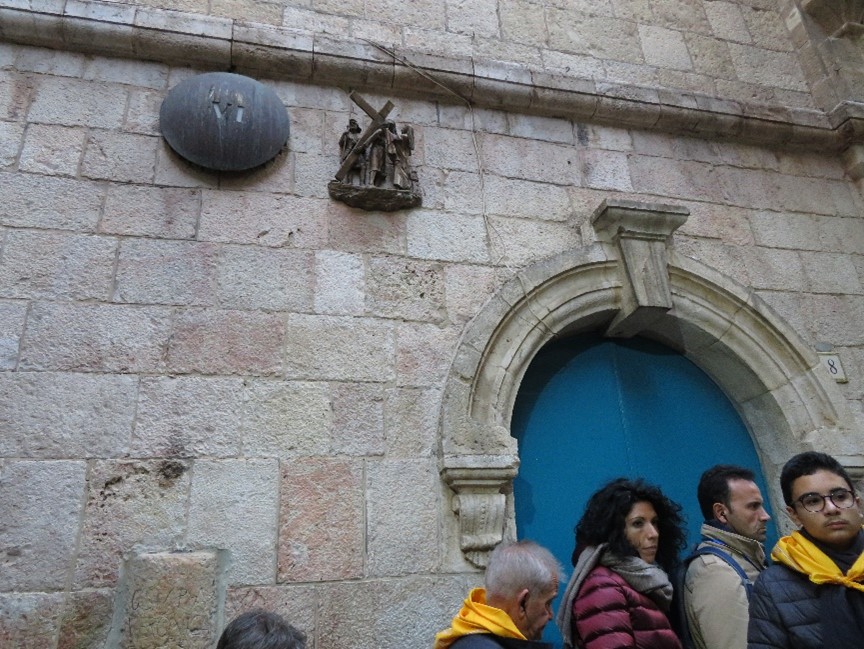
Sixth Station
The Sixth Station commemorates the place where, according to tradition, St. Veronica wiped the face of Jesus with her veil, leaving an imprint of His face on the cloth. The relic, known as the “Sudarium of Veronica,” is kept in St. Peter’s Basilica in Rome. Veronica’s name may derive from the Latin vera icon, “true image.” This legend is not present in Scripture, although the similar Image of Edessa is mentioned in the Epistles of Jesus Christ and Abgarus King of Edessa, a late piece of New Testament apocrypha. The image on the veil is a pre-crucifixion image and is distinct from the post-crucifixion Holy Face image on the Shroud of Turin. Scientific tests, however, have shown that the two faces match perfectly in size.
The location of the sixth station was identified as the site of the encounter in the 19th century. In 1883, Greek Catholics bought the 12th century ruins at the location, and built the Church of the Holy Face and Saint Veronica on the ruins. They claimed that Veronica had met Jesus outside her own house, and that the house had been on this very spot.
Reflection: Veronica offers her veil. I offer You all my love. Imprint Your image upon my soul.

Eighth Station
The Eighth Station commemorates Jesus’ encounter with the pious women of Jerusalem and His consolation of them. It is described in the Gospel of St. Luke (23:27-31). The letters ICXC (ΙΣΟΥΣ ΧΡΙΣΤΟΣ), a cross and the Greek inscription NIKA, “He conquers,” on the wall of the Greek Orthodox Monastery of St. Charalambos mark the place where Jesus consoled the lamenting women of Jerusalem.
Reflection: There are persons I weep about: _______. Please help them to carry their Crosses.
Stations 10-14 are all inside the Church of the Holy Sepulcher.
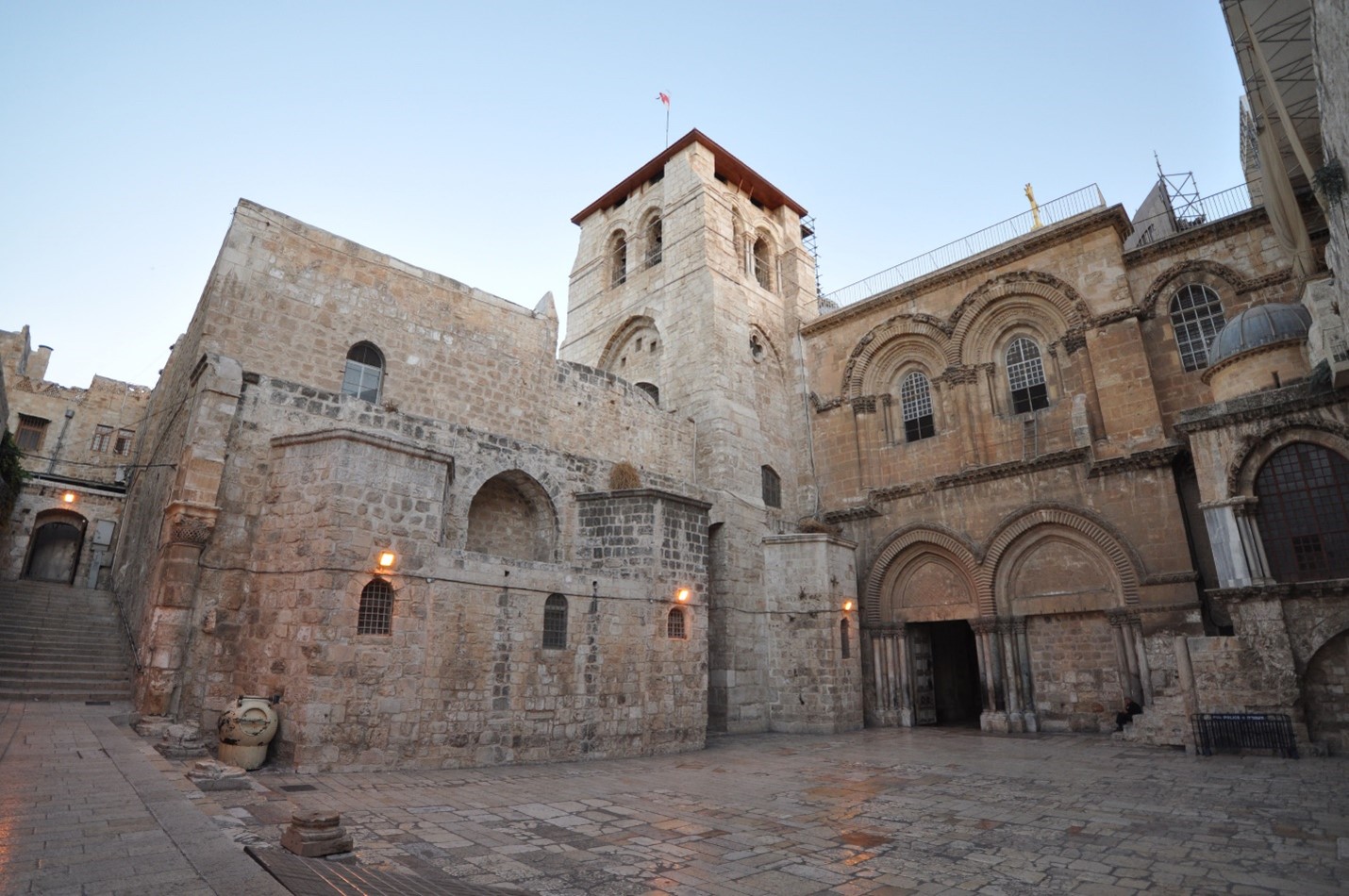
Church of the Holy Sepulcher is located in Jerusalem’s Christian Quarter.
Eastern Christians call this the Church of the Anastasis (“Resurrection” in Greek). It contains the two holiest sites in Christianity, Calvary where Christ died on the Cross on Good Friday and the tomb where He was buried and then rose victorious over sin and death on Easter Sunday. Early Christians venerated the site, but the Roman Emperor Hadrian (beginning in 135 AD) built a pagan temple to Venus over it. Constantine tore down the temple and began the construction of a very beautiful basilica in 326 AD. In the process, he had Christ’s tomb cut away from the original hill side. The Church was consecrated on September 13, in 335 AD (Binz, p. 261).
Throughout the centuries, there have been various invasions, desecrations, natural disasters, such as fires and earthquakes, and re-building of the Church. The current structure was built by the Crusaders in the 11th and 12th century and is shared by the Armenian, Greek Orthodox and Roman Catholic Churches, and to a lesser degree the Coptic Orthodox, Syriac Orthodox and Ethiopian Orthodox Churches.
As we enter the Church from the courtyard, we see a steep and curving stairway leading up to the hill of Golgotha (in Aramaic) or Calvary (in Latin). At the top right is a window looking into the Crusader Chapel of the Franks, commemorating the stripping of Jesus’ garments (Tenth Station). Calvary is split into two chapels, each with its own altar. Straight ahead is the Latin Catholic Chapel of the Nailing to the Cross (Eleventh Station). To the left is the more ornate Greek Orthodox Chapel of the Crucifixion where Jesus died on the cross (Twelfth Station). A silver disc beneath the altar marks the spot where the cross stood. As a pilgrim in 2019, I was able to touch the stone mound of Calvary through a round hole in the disc. The limestone rock upon which Jesus was crucified lies beneath the altar, under glass (Binz, p. 261, 263). This is where He died!!! It is so overwhelming that words, prayers, thoughts are insufficient to capture the moment, except maybe: “He loved us that much.”
Reflections:
Tenth Station: I vowed poverty. Strip me, too.
Eleventh Station: I vowed obedience. Nail me to the Cross.
Twelfth Station: You die on the Cross for me. Let me give You all that I am.
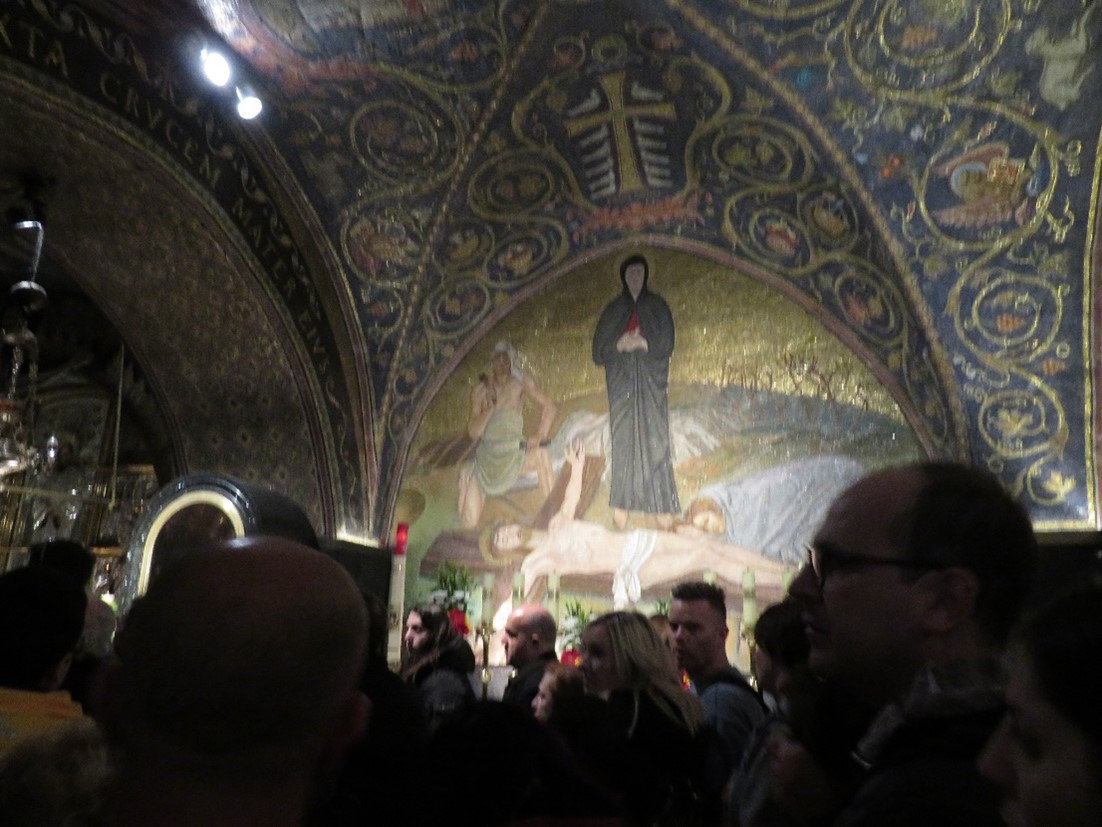
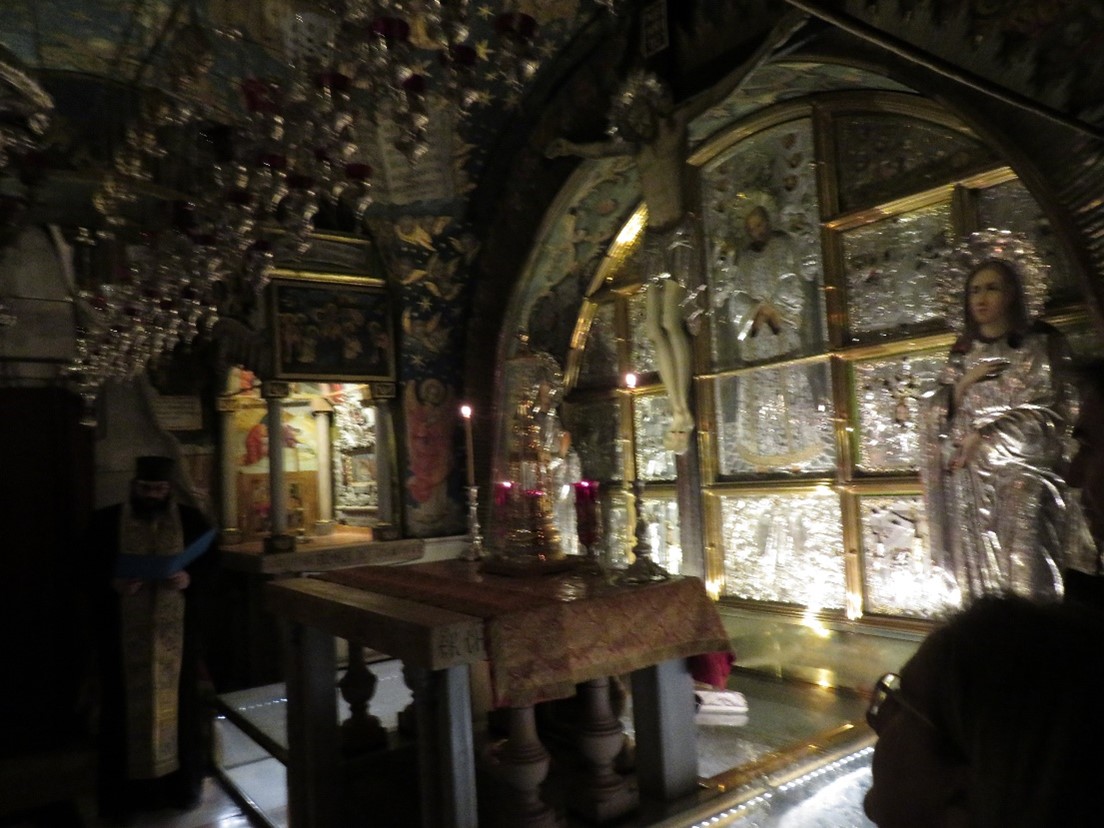
Between the two chapels, Greek Orthodox and Catholic, there is the Catholic Altar of the Stabat Mater (Our Lady of Sorrows). It commemorates the site where Jesus was taken down from the cross and held in the arms of His Mother (Thirteenth Station)
Reflection: Mother, I am so sorry.
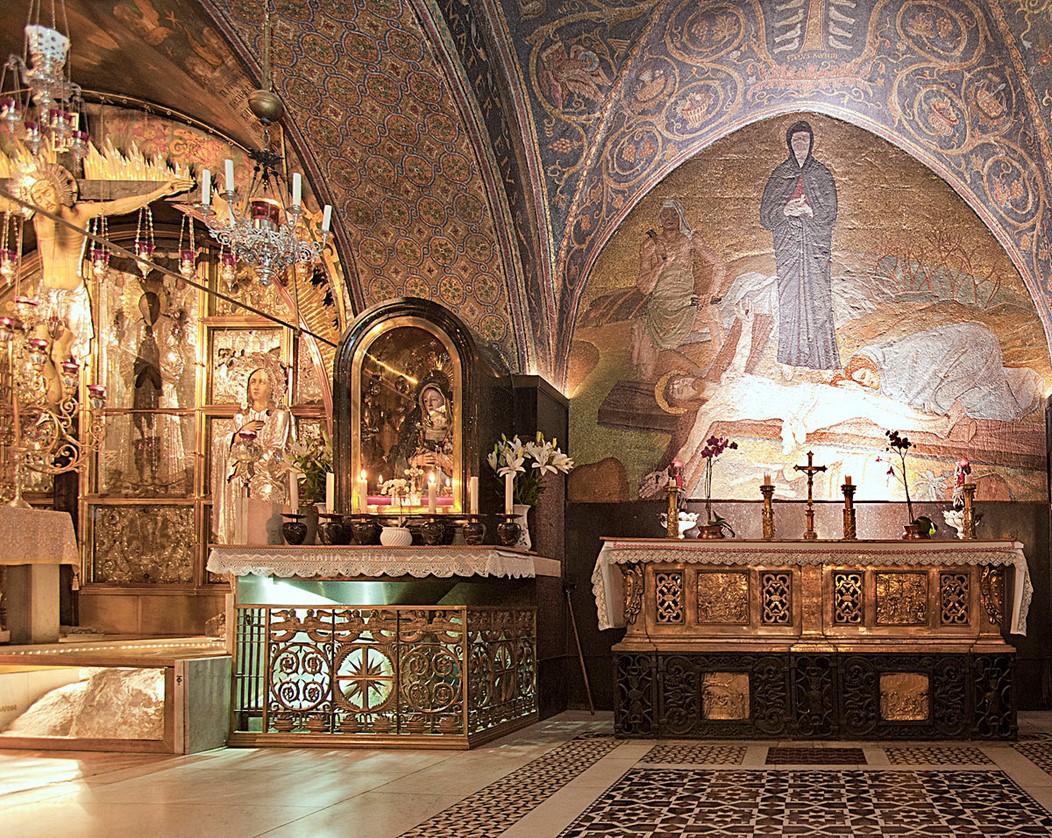
Stabat Mater altar: statue of Mary (left) with an 18th century bust marking the Thirteenth Station
At the rear of the Chapel of the Crucifixion, there is another flight of steps that leads down again to the ground floor. Here we find a rather large mosaic depicting three scenes: Jesus being taken down from the cross, His body being prepared for burial, and His body being taken to the tomb.
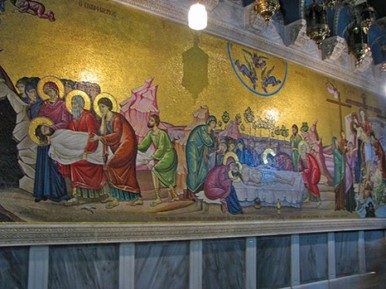
In front of the mosaic lies the Stone of Anointing which tradition holds to be the place where Jesus’ body was prepared for burial by Joseph of Arimathea. It is a reddish stone flanked by candlesticks with a row of lamps hanging over it (Alternate Thirteenth Station) (Binz, p. 263).
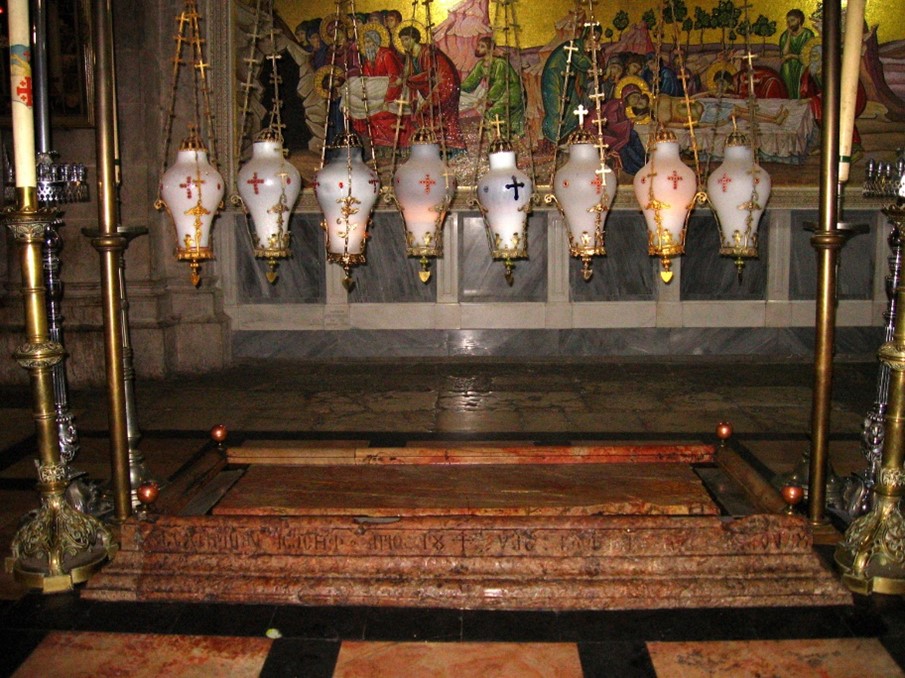
Stone of Anointing
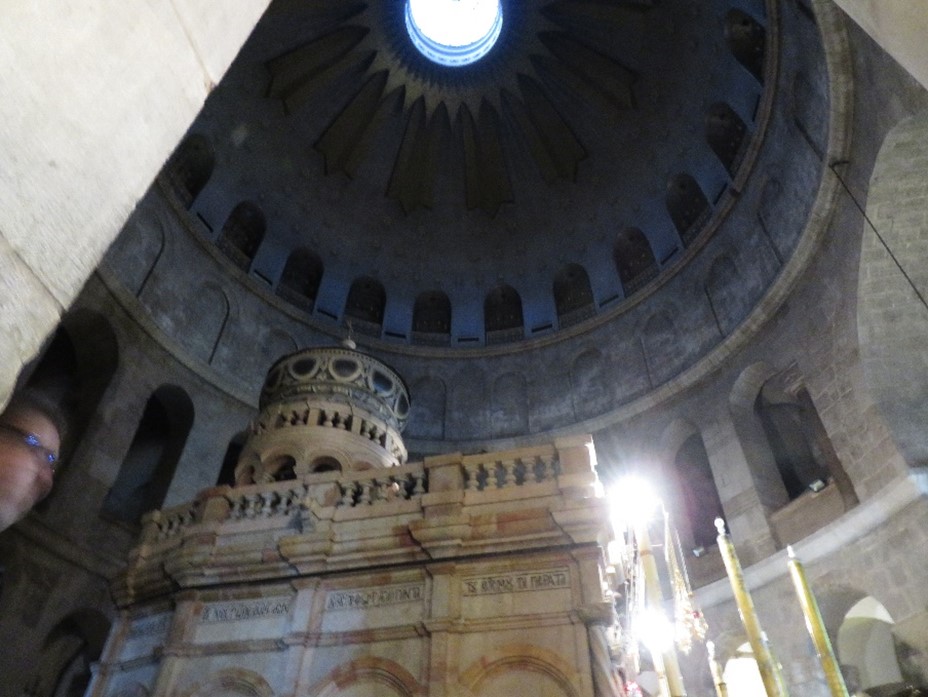
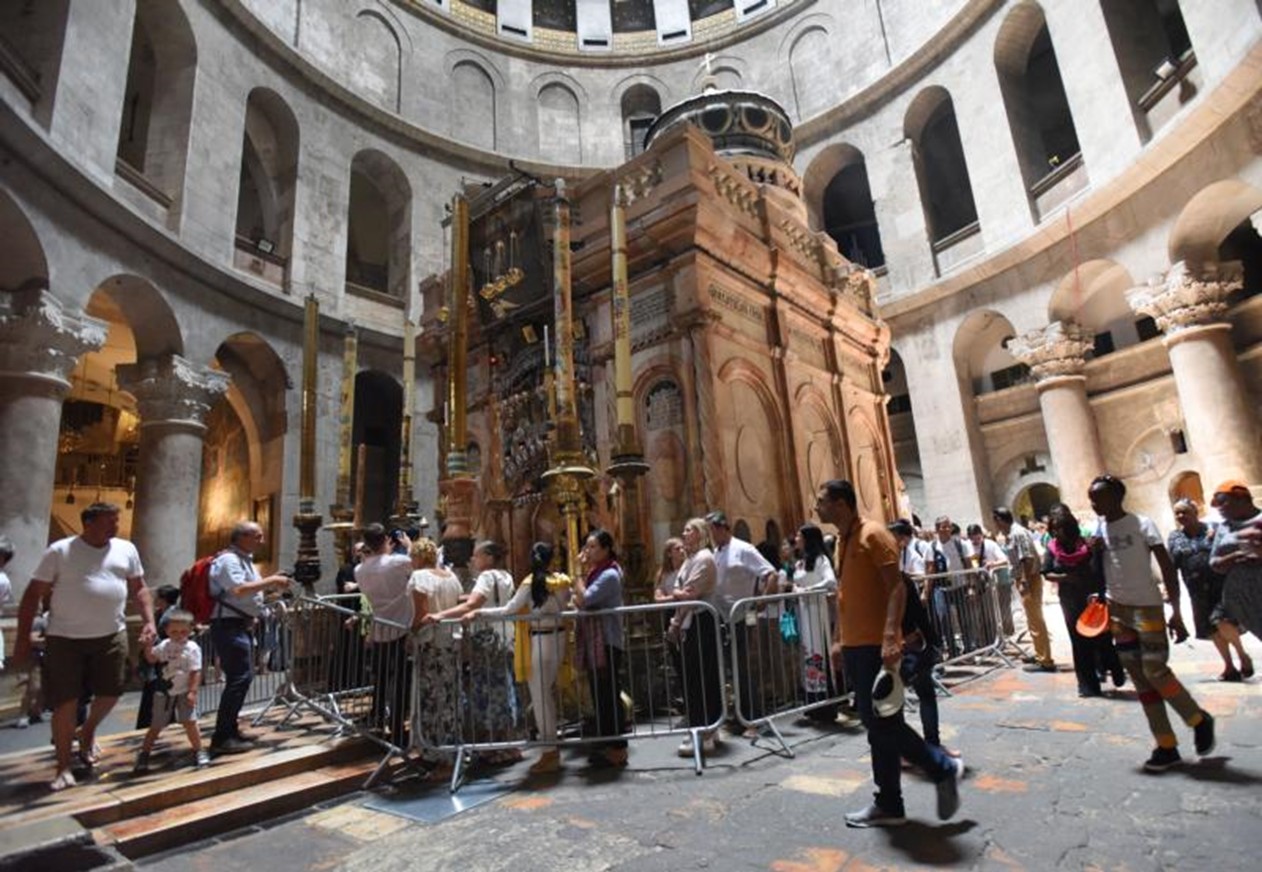
On the far west side of the Church is the rotunda with massive pillars supporting a huge dome. Its outer walls belong to the period of Constantine’s original 4th century basilica. The original rotunda was destroyed by fire in 1808 and rebuilt between 1809 and 1810. The underside of the dome is decorated with twelve rays of light representing the twelve apostles. In the center of the rotunda is a stone shrine called the Aedicule. There are two chambers in the Aedicule (small house or shrine): the outer chamber is called the Chapel of the Angel and holds a fragment of the large stone that sealed the tomb of Jesus. The inner chamber contains the tomb of Jesus (Fourteenth Station). A marble slab covers the rock bench on which the body of Jesus was laid. Pilgrims can touch this slab and place religious articles on it. At busy times, a Greek Orthodox priest has the glorious and blessed assignment of directing the pilgrims through the tomb. He allows each pilgrim 15-20 seconds to visit, pray, recall the gospel of the resurrection, and make a few petitions. Naturally, I had to go around again – a few times – until I was recognized by the good priest as doing so.
Reflection: Fourteenth Station: I have to die to myself. But in three days, You rose again, and You will call me home also.
You are the Mysterium Tremendum. You are the unfathomable God. You alone can bring joy out of suffering. I believe. Alleluia! (End of Stations of the Cross by Mother M. Ingeborg, FSGM)
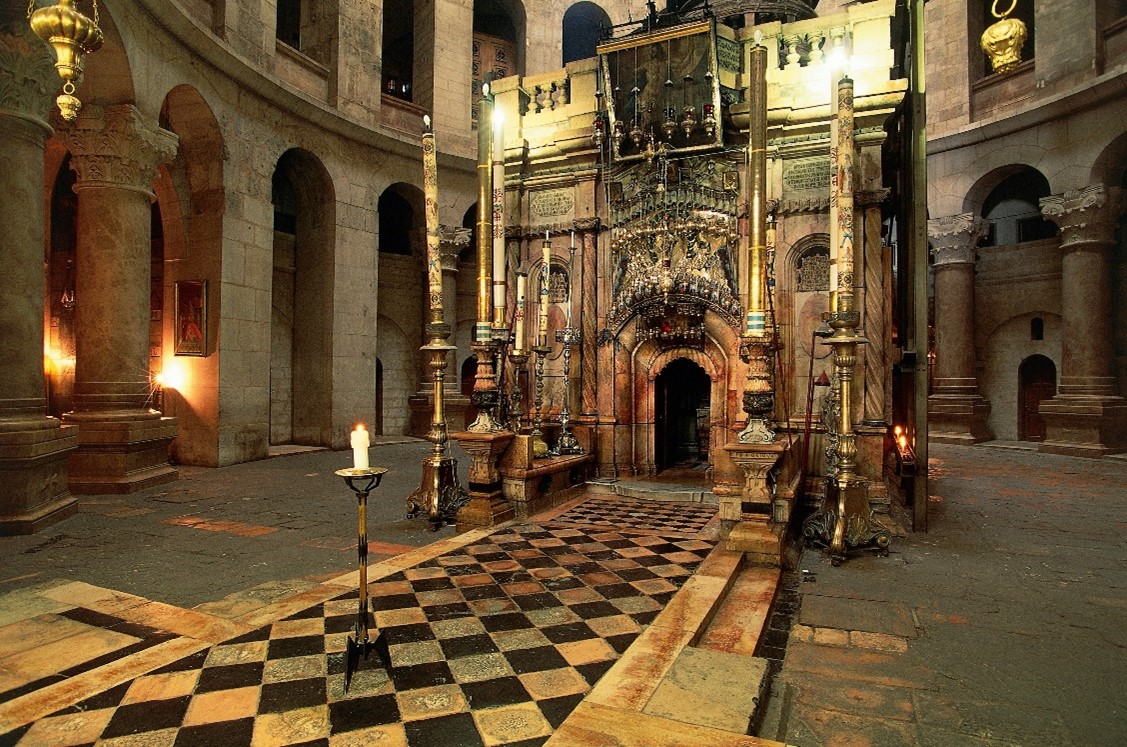
Entrance to the Aedicule: Tomb of Jesus
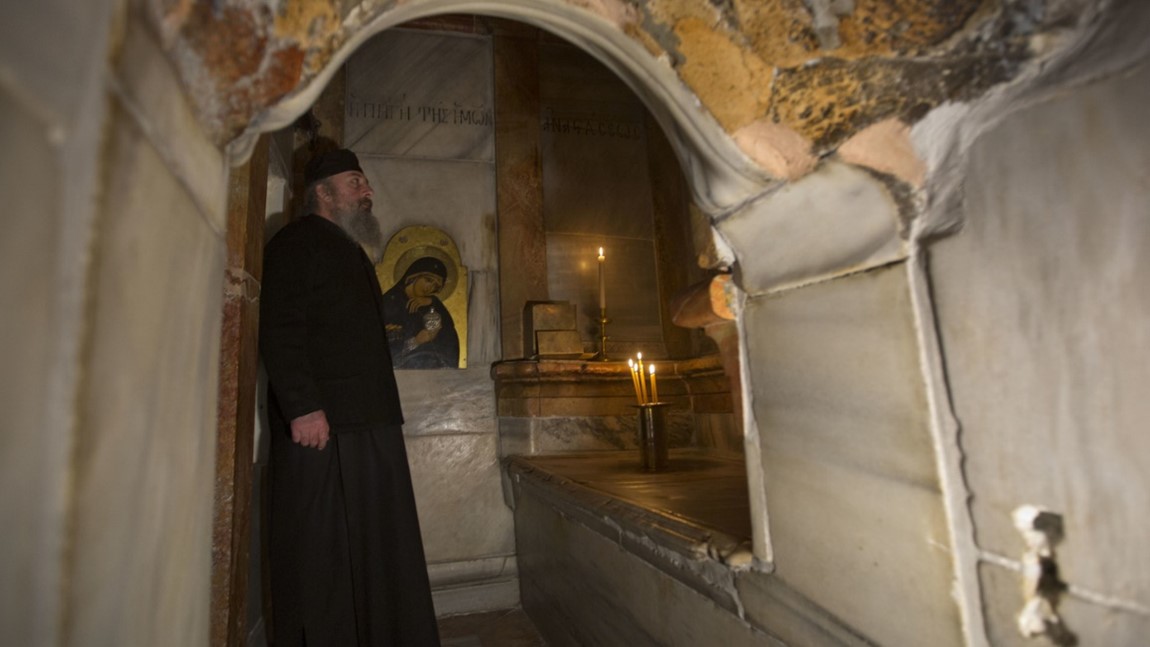
Tomb of Jesus
Just east of the rotunda is the Crusader structure housing the main altar of the Church. It is called the Catholicon and is now owned by the Greek Orthodox. Its dome contains the image of Christ the Pantocrator, ruler of the universe.
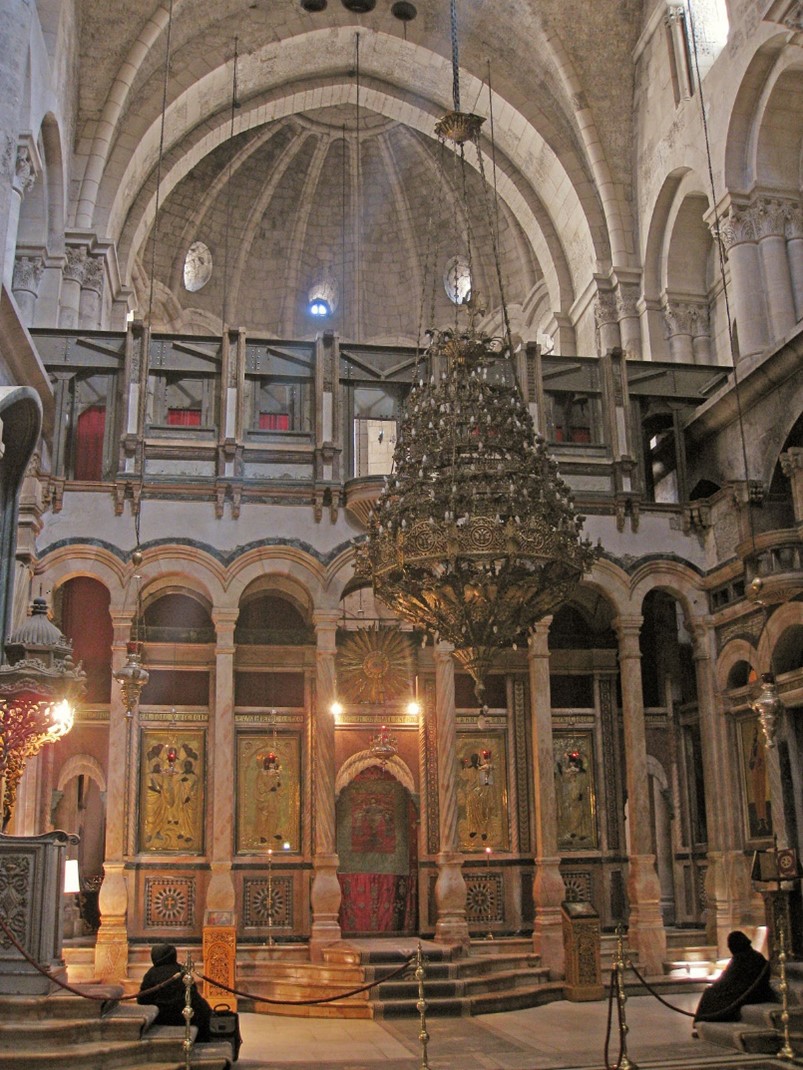
Catholicon

Christ the Pantocrator

The Coptic Chapel is located on the opposite side of the entrance to the Aedicule. It has some natural rock of the tomb.
West of the Aedicule, that is, behind it, is the Syriac Orthodox Chapel with the Tomb of St. Joseph of Arimathea and St. Nicodemus. Inside is the entrance to two Jewish tombs from the first century. Since the Jews always buried their dead outside the city, the presence of these tombs prove that the Holy Sepulcher was outside the city at the time of the crucifixion. It is believed that these two men, who took down and entombed the body of Jesus (John 19:38-42), were buried here. (Binz, pp.265-66).
Reflection: I often ask myself if I would have had the courage to ask Pontius Pilate permission to take down and bury the body of My Savior.
North of the Aedicule is the Franciscan Chapel of St. Mary Magdalene where Mary met Jesus after His resurrection. Directly north of this chapel is the Franciscan Chapel of the Blessed Sacrament or Chapel of the Apparition, commemorating Jesus’ appearance to His Mother after the resurrection. Here is also a piece of an ancient column supposedly a part of the pillar to which Jesus was tied during His scourging.
On the Northeast side of the Church, there is the Prison of Christ, alleged to be the place where Jesus and the two thieves were briefly held before the crucifixion.
Further on, there is semi-circular aisle on the East side where there are two chapels on the left. The first is the Greek Chapel of St. Longinus, the Roman soldier who pierced the side of Jesus with his spear and then proclaimed that He was indeed the Son of God. The second is the Armenian Chapel of the Division of the Raiment, recalling that the clothes of Christ were divided among the Roman soldiers.
Between these two chapels there is a set of stairs descending to the Chapel of Saint Helena. The Armenians own it and call it the Chapel of St. Gregory the Illuminator, the saint who brought Christianity to the Armenians in 301.
Another set of 22 steps from the Chapel of Saint Helena leads down to the Franciscan Chapel of the Finding of the Cross. This rough-walled area has been built within part of the ancient quarry, later converted into a cistern (Binz, p. 266). Here, Saint Helena, mother of Constantine, found the True Cross and other instruments of the Passion and crucifixion of Jesus. They were subsequently sent to Rome and are held in the Basilica di Santa Croce in Gerusalemme.
There are about 30 chapels in the Church of the Holy Sepulcher. We can visit the rest of them when we go actually, rather than virtually, on our pilgrimage to Jerusalem!!
Why is the Church divided among different groups? In 1757 the Ottoman Turks established a status quo, which upheld the state of affairs for various Holy Land sites, including the Church of the Holy Sepulcher. It was confirmed in 1852/3. Ownership of the Church is shared by the Greek Orthodox, the Catholics, and the Armenian Orthodox, with the Greek Orthodox controlling the larger part. In the 19th century, the Coptic Orthodox, the Ethiopian Orthodox, and the Syrian Orthodox acquired rights to use certain areas for worship which include shrines and other structures in and around the building. Over the years there has been no little contention among the groups.
Reflection:
Is this really the place where Jesus died and rose from the dead? For the short answer: history, archaeology and tradition all point to an indisputable, “YES.” Sisters, this is the ultimate pilgrimage. For over 2,000 years, pilgrims have come here to see, to pray and to remember. For those of us who cannot go to the Holy Land, let us use all the means that we have to familiarize ourselves with the place where Christ won our salvation. But above all, let us meditate on the love of God for us.
*Father John Kilgallen, a Jesuit biblical scholar and author of New Testament Guide (and friend of many years ago), wrote this: “When I sit in the Basilica of the Holy Sepulcher and realize that here is the place where my Savior died, the confession of Paul overwhelms me: ‘He gave Himself for me; while we were still God’s enemies, God gave his Son for us.’”
Let us ponder the whole text of St. Paul, Romans 5:8-10 (RSV):
“But God shows His love for us in that while we were yet sinners Christ died for us. Since, therefore, we are now justified by his blood, much more shall we be saved by him from the wrath of God. For if while we were enemies we were reconciled to God by the death of his Son, much more, now that we are reconciled, shall we be saved by his life.”
Finally, let us take some time here to ponder God’s love for us as expressed in these Scripture passages:
Romans 5:5 “And hope does not disappoint us, because God’s love has been poured into our hearts through the Holy Spirit which has been given to us.”
Deuteronomy 7:9 “Know therefore that the Lord your God is God, the faithful God who keeps covenant and steadfast love with those who love him and keep his commandments, to a thousand generations.”
John 3:16 “For God so loved the world that he gave his only Son, that whoever believes in him should not perish but have eternal life.”
1 John 3:1 “See what love the Father has given us, that we should be called children of God; and so we are. The reason why the world does not know us is that it did not know him.”
Hosea 2:23 “I will plant her for myself in the land; I will show my love to the one I called ‘Not my loved one.’ I will say to those called ‘Not my people,’ ‘You are my people;’ and they will say, ‘You are my God.’”
Let us pray that soon you will be able to come to Rome for an actual pilgrimage and even to the Holy Land to walk in the footsteps of Jesus and to encounter Him anew.
